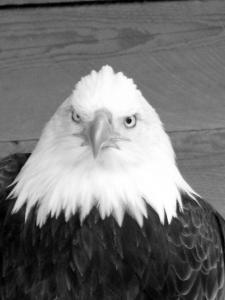On Monday, Sept. 16, Mike Billington ‘02 from The University of Minnesota’s Raptor Center presented a pair of eagles to students, staff, and members of the public in Olin’s Auditorium on the Gustavus Adolphus Campus. This educational program was directed to the students of Dr. Richard Leitch’s Environmental Politics class and was sponsored by the Environmental Studies Department as well as the Margaret A. Cargill Foundation.
Starting at 7 p.m., those in attendance were staring in awe at a large juvenile bald eagle by 7:10. After removing the first bald eagle from its cage, Billington, an interpretive naturalist from The Raptor Center at the University of Minnesota’s College of Veterinary Science, began handling and feeding the eagle with ease.
While the audience snapped pictures of the eagle tearing apart and eating an entire fish, Billington enlightened his listeners with many facts and interesting points about bald eagles.
After the juvenile bald eagle had been fed, Mike proceeded to retrieve an even bigger and arguably more majestic adult bald eagle from the second of two large raptor cages sitting in the front of the room. While feeding the adult bald eagle, Billington went into detail on the purpose and mission of The Raptor Center. With a main focus on rehabilitating and releasing raptors back into the wild, Billington emphasized the ongoing threats to eagles: humans.

Those in attendance needed no reminder as to why this bird of prey has existed as the symbol of American freedom and patriotism since the founding of the U.S. But underlying this symbolic bird is a larger concern for bald eagles and their environment. According to The Raptor Center, toxins make up the second largest contributor to the poisoning and death of bald eagles. This threat to eagles is due to the use of lead bullets.
Lead bullets, which are widely used in Minnesota for deer hunting, are finding their way into the digestive systems of bald eagles. Bald eagles are scavengers, preying on the deer that have been shot and killed but not recovered by hunters. Or eagles are eating the entrails that have been left in the woods after a harvested deer has been field dressed. In both cases, the lead bullet and its fragments are still exposed to the eagles. Sometimes this lead even makes its way into the venison eaten by humans and sold in stores.
Lead bullets have already been banned for waterfowl hunting after significant evidence has shown that the lead was entering the ecosystems and harming many organisms. In spite of this legislation, lead bullets are still available to hunters and is the preferred bullet for deer hunting.
Despite the scientific knowledge that lead bullets used during deer hunting season in Minnesota correlate to the number of poisoned and dead bald eagles, little has been done to stop the toxic bullets from making their way to store’s shelves in Minnesota.
Copper bullets are a safe and effective alternative to lead bullets, but they are more expensive. There has yet to be enough legislation to ban these poisoning bullets from being used in Minnesota.
The bald eagle has not only become a national symbol for the United States of America, it is the official national bird of the United States. We don’t have to give up our guns or our hunting rights to prevent the death of hundreds of eagles from lead poisoning every year. Yet, this symbol of freedom in the United States is at risk with a clear solution in sight.
The process of banning lead bullets, however, will be a long and complicated one requiring social and political action in Minnesota. This is the goal of the students in Leitch’s Environmental Politics class: to aid in producing this solution, so that bald eagles can live again without this human threat.
Until then, this ongoing threat in Minnesota will exsist alongside the unchallenged praise of the bald eagle as a national symbol.